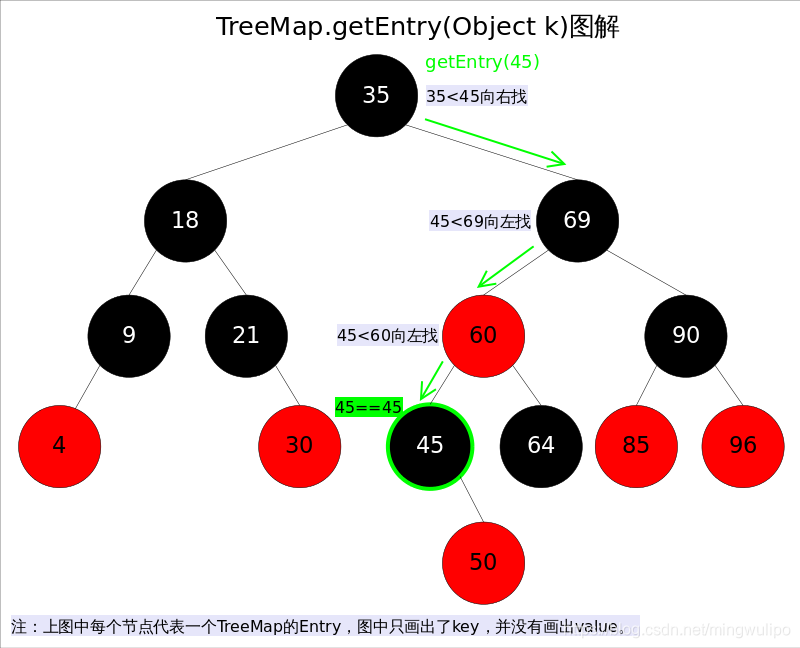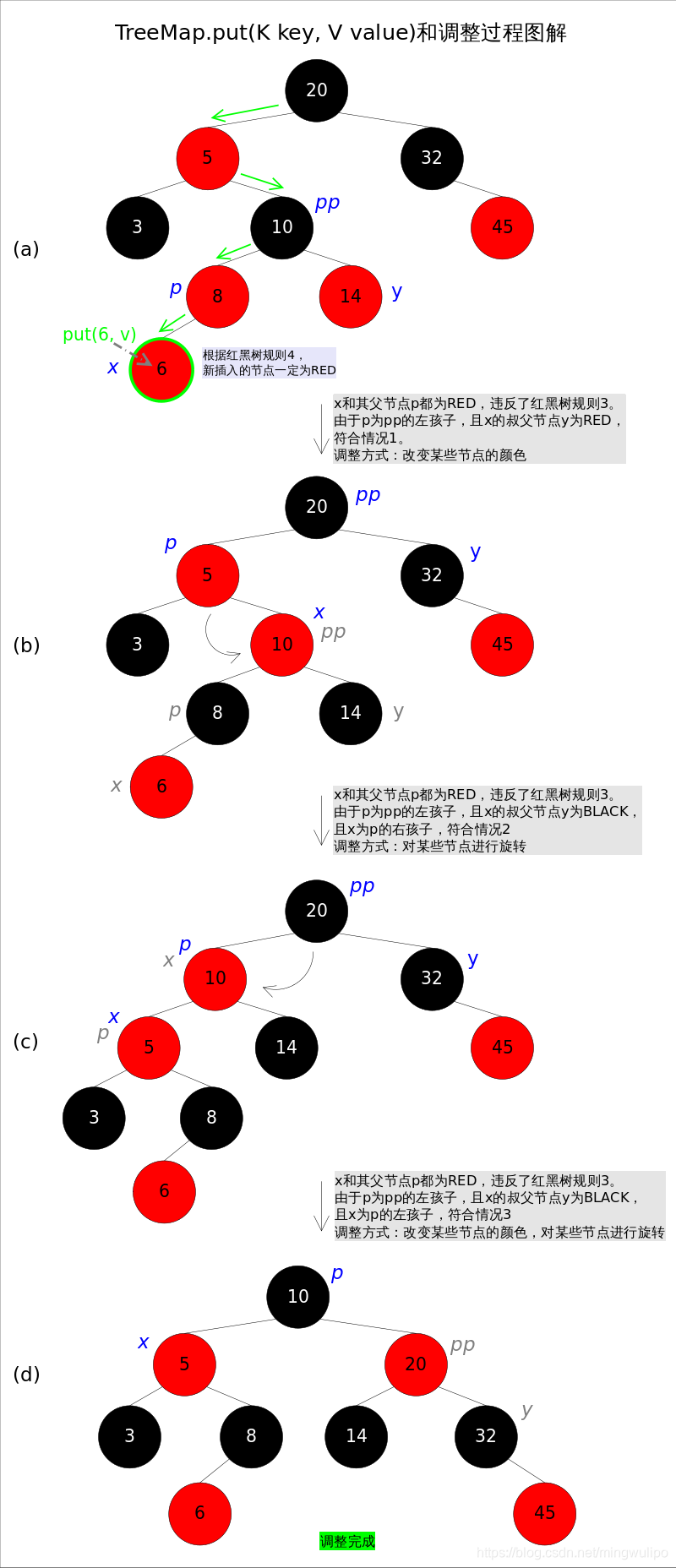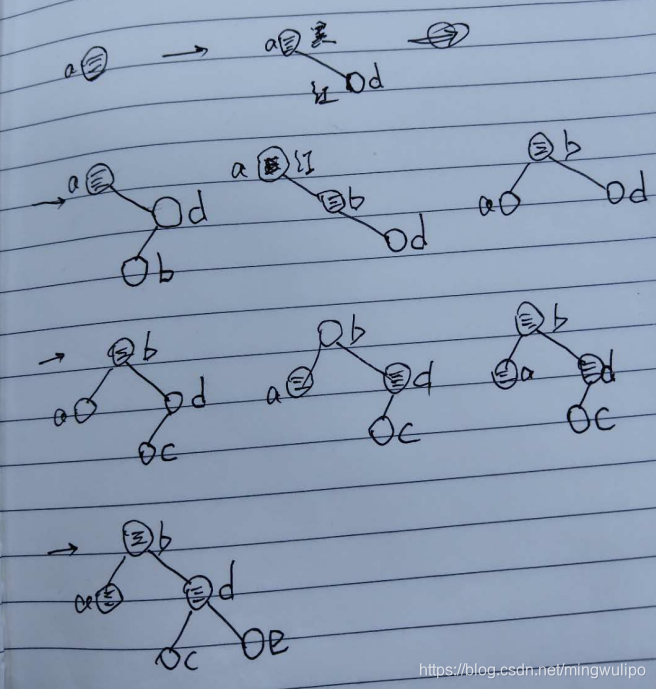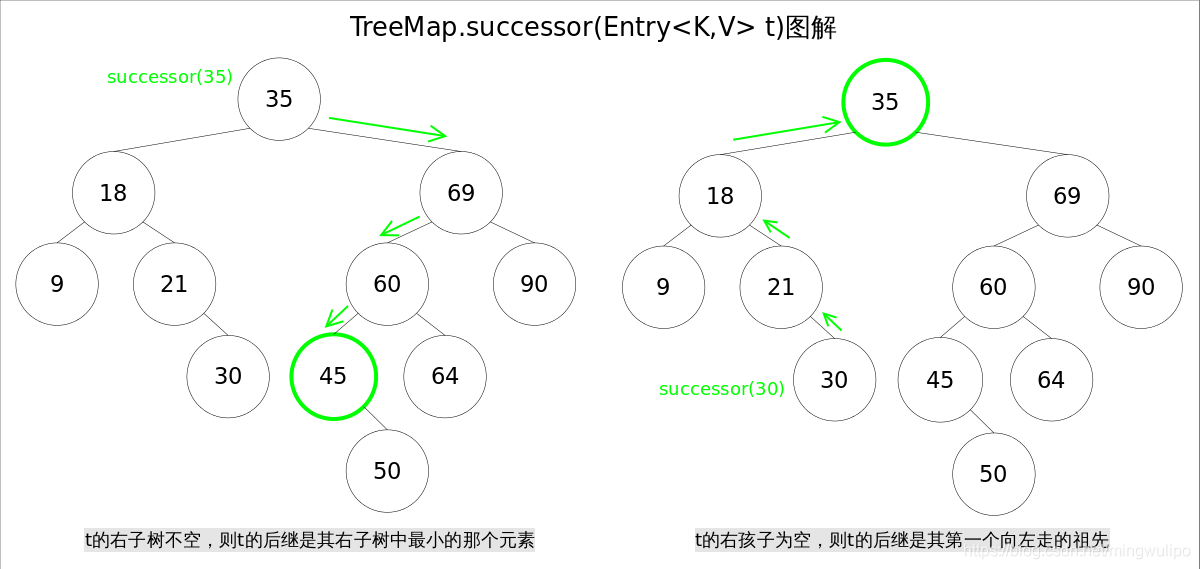使用
TreeMap使用比较器排序,按照key的排序遍历,
如果没有比较器,用默认比较器,key的类默认实现了Comparable接口的compareTo方法,比如Integer,String
key不能为null,value可以为null
Map<String, String> treeMap = new TreeMap<String, String>();
treeMap.put("a", "1");
treeMap.put("d", "4");
treeMap.put("b", "2");
treeMap.put("c", "3");
treeMap.put("e", null);
//treeMap.put(null, "f");//key不能为null
System.out.println("TreeMap:" + treeMap);//TreeMap:{a=1, b=2, c=3, d=4, e=null}
TreeMap是非同步的(not synchronized),线程不安全的。如果需要在多线程环境使用,需要程序员手动同步;或者通过如下方式将TreeMap包装成(wrapped)同步的:
SortedMap m = Collections.synchronizedSortedMap(new TreeMap(...));
类
public class TreeMap<K,V>
extends AbstractMap<K,V>
implements NavigableMap<K,V>, Cloneable, java.io.Serializable
public interface NavigableMap<K,V> extends SortedMap<K,V> {
构造
//使用默认比较器
public TreeMap() {
comparator = null;
}
用红黑树实现,Entry表示红黑树节点
static final class Entry<K,V> implements Map.Entry<K,V> {
K key;
V value;
Entry<K,V> left;
Entry<K,V> right;
Entry<K,V> parent;
boolean color = BLACK;
/**
* Make a new cell with given key, value, and parent, and with
* {@code null} child links, and BLACK color.
*/
Entry(K key, V value, Entry<K,V> parent) {
this.key = key;
this.value = value;
this.parent = parent;
}
查询
从根节点向子节点遍历,逐个用比较器比较。如果比根节点大,就用右孩子继续比较,如果比根节点小,就用左孩子继续比较,否则是相等,就找到了。有点像后序遍历。
public V get(Object key) {
Entry<K,V> p = getEntry(key);
return (p==null ? null : p.value);
}
final Entry<K,V> getEntry(Object key) {
// Offload comparator-based version for sake of performance
if (comparator != null)
return getEntryUsingComparator(key);
if (key == null)
throw new NullPointerException();
@SuppressWarnings("unchecked")
Comparable<? super K> k = (Comparable<? super K>) key;
Entry<K,V> p = root;
while (p != null) {
int cmp = k.compareTo(p.key);
if (cmp < 0)
p = p.left;
else if (cmp > 0)
p = p.right;
else
return p;
}
return null;
}
final Entry<K,V> getEntryUsingComparator(Object key) {
@SuppressWarnings("unchecked")
K k = (K) key;
Comparator<? super K> cpr = comparator;
if (cpr != null) {
Entry<K,V> p = root;
while (p != null) {
int cmp = cpr.compare(k, p.key);
if (cmp < 0)
p = p.left;
else if (cmp > 0)
p = p.right;
else
return p;
}
}
return null;
}

添加
public V put(K key, V value) {
Entry<K,V> t = root;
//添加第一个元素
if (t == null) {
compare(key, key); // type (and possibly null) check
root = new Entry<>(key, value, null);
size = 1;
modCount++;
return null;
}
//添加第二个元素
int cmp;
Entry<K,V> parent;
// split comparator and comparable paths
Comparator<? super K> cpr = comparator;
if (cpr != null) {
do {
parent = t;
cmp = cpr.compare(key, t.key);
if (cmp < 0)
t = t.left;
else if (cmp > 0)
t = t.right;
else
return t.setValue(value);
} while (t != null);
}
else {
if (key == null)
throw new NullPointerException();
@SuppressWarnings("unchecked")
Comparable<? super K> k = (Comparable<? super K>) key;
do {
parent = t;
cmp = k.compareTo(t.key);
if (cmp < 0)
t = t.left;
else if (cmp > 0)
t = t.right;
else
return t.setValue(value);
} while (t != null);
}
Entry<K,V> e = new Entry<>(key, value, parent);
if (cmp < 0)
parent.left = e;
else
parent.right = e;
fixAfterInsertion(e);
size++;
modCount++;
return null;
}
//红黑树调整函数fixAfterInsertion()
private void fixAfterInsertion(Entry<K,V> x) {
x.color = RED;
while (x != null && x != root && x.parent.color == RED) {
if (parentOf(x) == leftOf(parentOf(parentOf(x)))) {
Entry<K,V> y = rightOf(parentOf(parentOf(x)));
if (colorOf(y) == RED) {//如果y为null,则视为BLACK
setColor(parentOf(x), BLACK); // 情况1
setColor(y, BLACK); // 情况1
setColor(parentOf(parentOf(x)), RED); // 情况1
x = parentOf(parentOf(x)); // 情况1
} else {//没有叔叔
if (x == rightOf(parentOf(x))) {
x = parentOf(x); // 情况2
rotateLeft(x); // 情况2
}
setColor(parentOf(x), BLACK); // 情况3
setColor(parentOf(parentOf(x)), RED); // 情况3
rotateRight(parentOf(parentOf(x))); // 情况3
}
} else {
Entry<K,V> y = leftOf(parentOf(parentOf(x)));
if (colorOf(y) == RED) {
setColor(parentOf(x), BLACK); // 情况4
setColor(y, BLACK); // 情况4
setColor(parentOf(parentOf(x)), RED); // 情况4
x = parentOf(parentOf(x)); // 情况4
} else {
if (x == leftOf(parentOf(x))) {
x = parentOf(x); // 情况5
rotateRight(x); // 情况5
}
setColor(parentOf(x), BLACK); // 情况6
setColor(parentOf(parentOf(x)), RED); // 情况6
rotateLeft(parentOf(parentOf(x))); // 情况6
}
}
}
root.color = BLACK;
}
举例

添加5个元素示意图

删除
public V remove(Object key) {
Entry<K,V> p = getEntry(key);
if (p == null)
return null;
V oldValue = p.value;
deleteEntry(p);
return oldValue;
}
private void deleteEntry(Entry<K,V> p) {
modCount++;
size--;
// If strictly internal, copy successor's element to p and then make p
// point to successor.
if (p.left != null && p.right != null) {
Entry<K,V> s = successor(p);
p.key = s.key;
p.value = s.value;
p = s;
} // p has 2 children
// Start fixup at replacement node, if it exists.
Entry<K,V> replacement = (p.left != null ? p.left : p.right);
if (replacement != null) {
// Link replacement to parent
replacement.parent = p.parent;
if (p.parent == null)
root = replacement;
else if (p == p.parent.left)
p.parent.left = replacement;
else
p.parent.right = replacement;
// Null out links so they are OK to use by fixAfterDeletion.
p.left = p.right = p.parent = null;
// Fix replacement
if (p.color == BLACK)
fixAfterDeletion(replacement);
} else if (p.parent == null) { // return if we are the only node.
root = null;//只有一个根节点,置为null就是删除
} else { // No children. Use self as phantom replacement and unlink.
if (p.color == BLACK)
fixAfterDeletion(p);
if (p.parent != null) {
if (p == p.parent.left)
p.parent.left = null;//删除父子节点间的连接,就是删除节点
else if (p == p.parent.right)
p.parent.right = null;
p.parent = null;//删除父子节点间的连接,就是删除节点
}
}
}
寻找后继节点,就是比较器排序,比当前节点大的后一个节点
static <K,V> TreeMap.Entry<K,V> successor(Entry<K,V> t) {
if (t == null)
return null;
else if (t.right != null) {
Entry<K,V> p = t.right;
while (p.left != null)
p = p.left;
return p;
} else {
Entry<K,V> p = t.parent;
Entry<K,V> ch = t;
while (p != null && ch == p.right) {
ch = p;
p = p.parent;
}
return p;
}
}

删除举例
删除c,直接删除
























 1190
1190

 被折叠的 条评论
为什么被折叠?
被折叠的 条评论
为什么被折叠?








